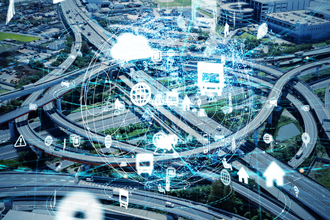We live in a time when innovation is expanding rapidly, generating constant updates of industry standards, due to the fast evolution of technology along with business requirements. Procurement teams need to be more up-to-date than ever before with the latest trends and technologies available to them, constantly facing the risk of being quickly overtaken by competitors if they do not use the same standard of tools and technology.
Developing a holistic and efficient procurement strategy by addressing the company’s specific procurement needs is a necessary aspect of optimizing procurement teams. Integrating an eprocurement system into the development strategy elevates procurement teams and enables stronger, faster, and higher-quality procurement.
What is eprocurement?
Eprocurement is an online B2B process through which goods or services can be ordered and purchased. An e procurement software facilitates the interaction between customers and their preferred suppliers, based on an online catalog.
Eprocurement uses a web interface or an app that connects customers with suppliers according to criteria set by each of them. Each company has its own set of procurement policies and rules, and the eprocurement system automatically ensures that all of these are met at each procurement.
Eprocurement helps automate the procurement process. Centralized transaction tracking, simplified reporting, and contract compliance help reduce delivery times and shorten procurement cycles.
How does e-procurement work?
Purchase requisition: Usual forms, questionnaires and all manual tasks are completely eliminated, being replaced by automatic processes that use the preset data. The process works by connecting different entities and processes through a centralized platform. Supplier Management, representing the interactions between supplier customers, and showing the performance of the relationship between them. With e-procurement benefits, the relationship between the two entities is improved and greatly simplified. Sourcing & Contract Management, the E2E process that companies go through to research, verify, select and manage vendors that can provide the inputs they need to function. A very complex and often lengthy process that in e-procurement becomes a very simple operation.
Common challenges of manual procurement
Traditional procurement processes are often characterized by manual and resource-consuming activities. Even with a certain level of automation, the processes are complemented by transactions and manual activities such as emails, spreadsheets ans phone calls, and these operations generate an often confusing and costly involvement with suppliers.
- Risk Management. There are huge risks throughout the supply chain starting with managing the single supplier contracts, market risks, potential frauds, cost, quality, delivery risks, non-conforming expenses, and dealing with compliance risks like policy adherence, anti-corruption issues. Procurement professionals need to identify the best suppliers and continuously monitor suppliers to ensure that all delivery requirements and standards are met.
- Poor supply chain transparency. Lack of supply chain visibility is one of the major procurement challenges. Visibility along the supply chain is an important tool for regulatory requirements and risk mitigation.
- Control and visibility. Acquisitions made outside the company’s established procurement procedures are indirect expenses that result in loss of revenue and control. When ordering kits, there are often unwanted additional items that cannot be easily accounted in financial and inventory records, and this complicates the procurement strategy, departmental budgets, inventory management and financial audits. Controlling expenses too rigorously could delay procurement processes and is often not an option.
- Problems With Documentation. Upon receipt of the goods, any problem is approached in a similar way to the information transfer between the purchaser and the supplier. In addition, the processes for accepting goods are often overlooked and invoices remain unpaid until some manual follow-up is carried out by the financial department or the supplier.
What are the Benefits of EProcurement?
Operational efficiency:
- Time efficiency. The way to take control of our daily routine and start to use the time to our advantage. The way to make ourselves the most productive in the shortest amount of time. Every company, every department and every person needs continuous time efficiency, but most of the time the procurement policies involve a series of routine activities meant to maintain results at high standards. Eprocurement automates all company policies, helping to minimize operations, even eliminating them completely. As the procurement department is relieved of manual, repetitive, or low-value tasks, it can redirect resources to higher-value activities, such as contract negotiations.
- Cost efficiency. The act of saving money by changing a product or process to make it work better. This is done to improve the company’s end result by lowering acquisition costs and improving overall efficiency. Eprocurement system with its built-in monitoring tools reduce overhead for purchasing teams, optimize performance, increase process efficiency and achieve cost savings. It also helps to limit non-compliant expenses, purchases outside the parameters set by the company’s policies.
Increased visibility:
- Purchasing portfolio improvement. Eprocurement benefits helps buyers to understand where their products are classified in terms of supply risk and profit contribution and thus to address an appropriate purchasing strategy. With eprocurement, companies have access to a wider selection of products and services to meet their specific needs. The ability to quickly locate products from your preferred suppliers or sellers helps control stock size and costs.
- Reporting and analytics. Both collecting existing information and presenting it in an easy-to-use and digestible way, and adding value to help inform a decision, are among the most commonly used features in business today. Eprocurement collects data and organizes it using tools such as graphs and tables, next the data is used to gain valuable insights into how companies can improve their performance. All information is centralized so that company management can easily access it to start the decision-making process.
Eprocurement System Buying Guide
Buying such a product is not easy, but a perfect match could be the last difficult purchasing decision you will ever have to make. A sustainable e-procurement solution facilitates digital transformation, which allows for integration with existing technology in the company and keeps pace with rapid changes in technologies, including artificial intelligence (AI). There are solutions suitable for every business and adaptable to any company, so you should not compromise on this choice.
Feature set is the first step to check, and you need to consider how the features offered by the software match your company structure, check the followings:
- Approval workflows: usually there are several levels of approval for a purchase transaction, and the entire flow must be transparent and according to the logic approached by the company. The approval flow offered by the software must be compatible with your company’s policy, it must provide transparency on the internal approval steps and very importantly it must make the formalities as efficient as possible.
- Three-way match: an accounting control that ensures that the purchase order, inventory receipt, and invoice all match in terms of product, quality, quantity and price. The software must allow you to customize the features, and modify their attributes for a perfect fit.
- Reporting and analytics: from the initial data for business cases, or budget forecasting, to the periodic reporting, all the necessary data must be found in the reports of your new software, accessible in a graphical or diagram presentation.
- Software implementation: In the process of choosing an e-procurement solution must also take into account the implementation capabilities of the moment. There are also cloud solutions that provide all the features along with the necessary visibility and a robust framework to succeed in managing your business expenses.
During the search you can discover useful functionalities that you did not take into account, and which exactly match the way your company works and which solve problems that you found unsolvable.
Recommended Reading

The Ultimate Guide to Choosing the Right eProcurement Software in 2022
To make things easier, here are some of the best eProcurement software available in the market.

8 Benefits of Establishing an E-Procurement Process
Despite so many paradigm shifts in technology, procurement processes have ...


